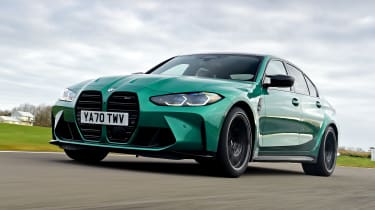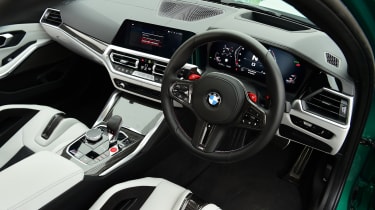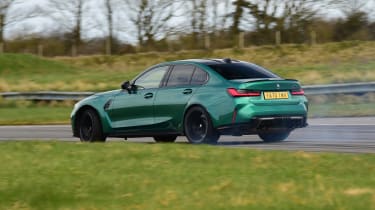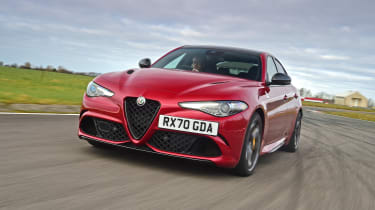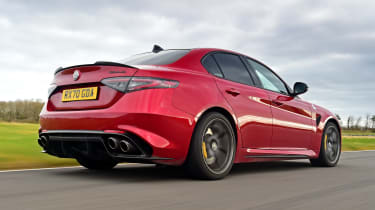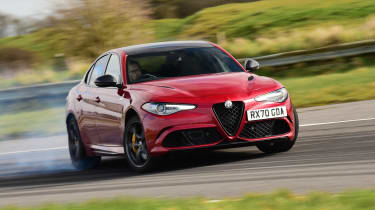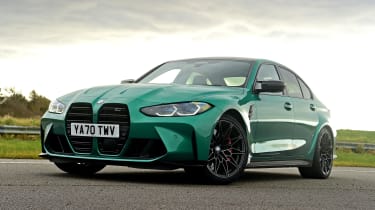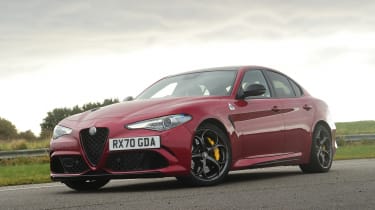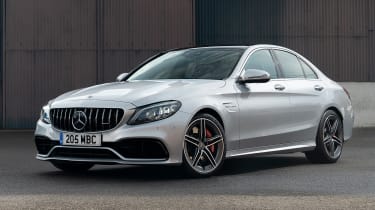BMW M3 Competition vs Alfa Romeo Giulia Quadrifoglio
Can the Alfa Giulia Quadrifoglio fend off the new BMW M3 Competition in this sports saloon shootout?
BMW has a rich pedigree and quite some form when it comes to developing high-octane, high- performance saloons. The M3 has been central to the Bavarian firm’s success for decades and now there’s an all-new version – and you certainly can’t miss it.
With its snarling snout and flared arches, this new M3 is perhaps the most controversial there has ever been. Its design will intrigue some but turn off others, yet equally controversial is the use of four-wheel drive for the very first time. Happily, for some people, the all-wheel-drive system is an optional extra, so as standard the M3 retains its rear-wheel-drive layout.
Never short of competition, here the M3 is squaring up to the highly accomplished and beautiful Alfa Romeo Giulia Quadrifoglio. The saloon has also recently had a number of updates, largely focused on improving its on-board tech. What hasn’t been messed with is the fabulous 2.9-litre V6 engine that develops 503bhp.
On paper, they match each other punch for punch, but let’s see who lands the knockout blow on road and track.
BMW M3
| Model: | BMW M3 Competition |
| Price: | £74,755 |
| Engine: | 3.0-litre 6cyl turbo, 503bhp |
| 0-62mph: | 3.9 seconds |
| Test economy: | 15.5mpg/3.4mpl |
| CO2: | 228-234g/km |
| Annual road tax: | £1,850 |
The M3 has long been the most focused edition of BMW’s compact executive saloon. This latest generation is the most powerful and quickest there has ever been, and starting from £74,755, it’s also never cost so much. But is that price tag justified?
Used - available now

2020 Suzuki
SX4 S-Cross
46,548 milesManualPetrol1.4L
Cash £11,997
2020 BMW
X2
44,368 milesAutomaticPetrol2.0L
Cash £14,997
2021 SEAT
Ibiza
18,736 milesManualPetrol1.0L
Cash £14,897
2023 Land Rover
Discovery
13,183 milesAutomaticDiesel3.0L
Cash £57,500Design & engineering
Despite the great lengths BMW engineers have gone to make the new M3 the fastest and most powerful version of the performance saloon ever, the main topic of discussion will be its design.
We’re not here to tell you if the M3 looks any good or not – that’s an entirely subjective topic – but put it this way: there has never been a more divisive- looking BMW in the past 20 years.
Mechanically, the M3 moves on to BMW’s CLAR set of chassis components, like those used by the larger M5. But more significantly, the M3 is now being offered with xDrive four-wheel drive for the first time. The system will be an optional extra, costing around £2,000, but customers won’t be able to order it until later in the summer.
The engine is also new; the 3.0-litre twin-turbo six-cylinder motor might have the same number of cylinders and displacement as before, but it’s a completely new unit with revised turbochargers and a new fuel-injection system. In Competition spec, the only version offered to UK buyers, it develops 503bhp and 650Nm of torque – that’s a 56bhp upgrade over the previous M3. As a result, BMW says that’s good enough for 0-62mph in 3.9 seconds.
The suspension comprises a double-wishbone set-up at the front and a five-link arrangement at the rear. Adaptive damping and an Active M differential come fitted as standard, while the M3 gets 19-inch wheels at the front and 20-inch rims at the back.
Inside, the overhaul is more restrained, because the M3 uses the same basic architecture you get in a regular 3 Series, which is no bad thing. What really sets the cabin apart are the sport seats, which come as part of an optional £6,750 M Carbon pack, but really do make the interior feel special.
Driving
Behind the flared arches and headline power figures, the first thing that strikes you about the M3 is how accommodating it feels. The previous M3 was quite wild and unforgiving, but this latest one feels more forgiving and easy to get along with day to day.
You don’t have to travel far to notice the more supple ride, which is firm, but the damping feels a lot more resolved and is much better at rounding off bumps in the road to ensure smoother progress.
Putting its more user-friendly personality to one side and viewing the M3 as a performance car, it’s clear that BMW engineers have really moved the game on. Central to that is the 3.0-litre engine. Once you climb beyond 2,500rpm and the turbos really begin to wake up, a tidal wave of torque slingshots the M3 down the road. It develops the same amount of power as the Alfa and fractionally more torque, but the M3 feels noticeably quicker than the Giulia.
There’s little need to rev the BMW’s engine to its 7,000rpm limit, because you can lean on that wall of torque to maintain momentum lower down the rev range. The eight-speed automatic cuts cleanly through the gears as you build speed, but it can be a little hesitant if you ask for multiple downchanges in quick succession. On track, the M3’s natural balance really shines. At 1,805kg, it’s a seriously heavy car, 185kg more than the Alfa, but the BMW simply doesn’t feel it. It masks its weight incredibly well, due to the excellent body control and a willingness to change direction at speed. The steering is a little numb, but the throttle response is super-sharp, allowing you to easily modulate the power so it never feels snappy or intimidating to drive.
Practicality
At its core the M3 is still a 3 Series saloon, so is more usable day to day than you may think. The 480-litre boot matches the Alfa’s and is a decent size . You can drop the rear bench to increase the area, but BMW doesn’t publish a figure for how much space there actually is.
Room in the back is good enough for two adults and if you opt for the M Carbon pack that adds the wonderful sports seats like in our test car’s, they boost the amount of foot space because passengers have more room to slide their feet beneath them.
The rest of the M3’s cabin feels bang up to date and build quality is first rate, unlike the Alfa’s. But some buyers may feel it difficult to stomach the £990 option for an electric boot lid on a car that starts from almost £75,000.
Ownership
Having said that, there is a very generous amount of standard kit, including a whole host of safety tech such as lane-departure warning, blind-spot assist, cruise control and full suite of parking sensors .
BMW’s warranty on the M3 is slightly more generous than the industry standard, covering four years/50,000 miles, but the brand finished a lowly 27th out of 30 in our Driver Power 2020 survey. By contrast, Alfa finished in ninth position.
Running costs
Not only is the M3 expensive to buy, it’s also extremely costly to run. On a test, which included a track assessment and motorway miles, the M3 managed 15.5mpg, which was slightly better than the Alfa’s 13.4mpg average.
So although this is not fully representative of how buyers will use the car every month, it means that if your economy does drop that low you can expect to pay almost £4,300 per year in fuel over 12,000 miles.
For the lower-rate earner to run as a company car, the M3 will cost £5,391 a year, which is £500 per year more than the Alfa. A set of Michelin Pilot Sport 4 S tyres will cost you around £1,000 to buy and fit.
Testers’ notes
“The arrival of xDrive four-wheel drive to the M3 is big news, but more exciting is the confirmation of an M3 Touring estate version, which is due to arrive in showrooms in 12 months’ time.”
Alfa Romeo Giulia Quadrifoglio
| Model: | Alfa Romeo Giulia Quadrifoglio |
| Price: | £67,995 |
| Engine: | 2.9-litre 6cyl turbo, 503bhp |
| 0-62mph: | 3.9 seconds |
| Test economy: | 13.4mpg/2.9mpl |
| CO2: | 235g/km |
| Annual road tax: | £1,850 |
Alfa’s Giulia Quadrifoglio marked the welcome return to form we’d waited so long to see from the firm. At £67,995, the Alfa is a good chunk cheaper than the BMW and packs similar performance. But can it match its German rival on road and track?
Design & engineering
You’ll be hard-pressed to find someone that would put the Alfa behind the BMW in a beauty contest. The Giulia Quadrifoglio may have been around for four years, but it still looks fresh and less polarising than the M3. Beneath that flamboyant Italian bodywork also lies a highly accomplished machine; the Giulia uses Alfa’s aluminium-intensive Giorgio platform, which houses a 2.9-litre twin-turbo V6 at the front, an eight-speed automatic in the middle and a differential with torque vectoring on the rear axle to help make best use of all 503bhp and 600Nm of torque.
The Alfa is considerably lighter than the BMW to the tune of 185kg. But despite both cars developing 503bhp, Alfa claims that the Giulia is only a match for the M3 with a 0-62mph time of 3.9 seconds. However, it can romp on to a top speed of 191mph, unlike the BMW’s capped 155mph limit.
Alfa recently introduced a series of upgrades to the Giulia, including new smoked LED rear lights, but the main update was inside with a revised infotainment system and added safety tech. The 8.8-inch central display is now a touchscreen and more configurable so buyers can display the information they want or need on a main home screen. The old-school, hooded analogue dials remain behind the steering wheel, however.
What hasn’t improved is build quality, and up against the M3 the Alfa’s shortcomings in this regard really stand out. Our test car had barely covered 1,500 miles but the DNA drive mode controller on the centre console had already cracked, along with the plastic covering on the gear selector.
Driving
Those shortcomings on interior quality can be quickly overlooked once you get behind the wheel, because on the road the Giulia is a real peach to drive.
The V6 kicks out 503bhp, identical to what you get in the BMW, but the Alfa’s 2.9-litre unit certainly sings a sweeter tune, helped by the optional Akrapovic sports exhaust. Work your way through the eight-speed automatic, which seamlessly goes about its business, and each shift is accompanied by rasps and snorts from the back end.
It seems more keen to rev to its 7,300rpm red line than the BMW but lacks the M3’s mid-range punch; it feels like there’s a greater torque deficit (50Nm)than the numbers suggest. The powertrain isn’t as clinical as the BMW’s yet it is more entertaining.
The Alfa’s steering trumps the BMW’s. It’s a very natural weight from lock to lock and the wheel brims with feel; there’s a genuine connection between the movement of your hands and where the car’s nose goes. You can place the Alfa with real accuracy on the road such is the sweetness of the steering.
It rides superbly well, with a deftness that makes long motorway drives a breeze. It’s backed up by good body control that you can tighten with the adjustable dampers; you can isolate them, too, having the engine and gearbox in an aggressive Race setting but with the more supple of the two dampers modes engaged. It makes for a very forgiving and fluid car to drive at speed. There’s no fancy 10-stage traction control system like on the BMW, but it always feels pleasingly balanced once you turn into a fast corner, helped by its lighter kerbweight and precise steering.
Practicality
While the Giulia is marginally shorter than the M3 and has a fractionally shorter wheelbase, on the whole there’s still plenty of space for four adults to sit in comfort. Head and legroom are both pretty generous and the only gripe for those in the back will be the chunky transmission tunnel, which does rob a bit of foot space from whoever is sitting in the middle.
The 480-litre boot is an identical size and shape to the M3’s, and although the rear bench splits 40:20:40 for increased flexibility, Alfa doesn’t quote a capacity figure for when the seat backs are dropped.
Where you’ll have to make sacrifices is in build quality; the Alfa isn’t badly built, it just doesn’t come close to the BMW’s standards. And the issues we’ve mentioned, regarding the cracked gear selector and drive-mode dial, don’t fill you with confidence about how the car will stand up over several years of use.
Ownership
Despite Alfa’s patchy past when it comes to reliability, owners that took part in our Driver Power 2020 satisfaction poll rated the manufacturer highly, finishing ninth place, well ahead of BMW in 27th.
Thanks to an update last year, the Giulia also now comes with a raft of standard Advanced Driver Assistance Systems (ADAS) kit, including lane-keep assist, active blind-spot assist, active cruise control and traffic-sign recognition.
Running costs
On our test the Alfa returned a rather poor 13.4mpg, which was only marginally worse than the BMW, but the evaluation did include track assessment as well as motorway miles.
If you plan to use the Alfa on track regularly, or just take advantage of its performance, you’ll be looking at an annual fuel bill of almost £5,000 if you cover 12,000 miles. Also consider insurance and road tax; due to its high CO2 emissions the Alfa has a first-year VED fee of £1,850, the same as the BMW. Your annual insurance premium will also be around £1,200.
A lower-rate taxpayer can expect to pay annual company car tax of £4,891, which is £500 less than the M3. But whichever way you cut it, these performance saloons are not cheap cars to own.
Testers’ notes
“The compact performance market has long been dominated by the Germans, so it’s a breath of fresh air that Alfa has finally come up with something that can compete.”
Verdict
First place: BMW M3
BMW has reworked the M3 into a more user-friendly performance saloon, one with a broader breadth of ability but that still delivers thundering performance. There’s an added layer of polish to the way the M3 goes about daily driving, so if you can stomach the fuel bills, you could use it every day. It’s practical, tech-packed and seriously quick. Whether you can live with the way it looks is up to you.
Second place: Alfa Romeo
The pedigree and years of engineering expertise that have gone into the new M3 meant the Alfa had a challenge on its hands. Yet the Quadrifoglio remains an excellent and fully recommendable performance saloon that is quick enough for the road and has a wonderful chassis. But against the M3 it falls short for tech, performance and build quality, which really should be better on a car approaching £70,000.
Also consider...
Audi RS 5 Sportback
- Price: £70,500
- Engine: 2.9-litre 6cyl, 444bhp
Audi's use of quattro four-wheel drive means that while the RS 5 is less powerful than the BMW, it can match it with a 0-62mph time of 3.9 seconds. However, the Audi doesn’t match the M3 when it comes to agility or handling balance on track.
Mercedes-AMG C 63 S
- Price: £74,258
- Engine: 4.0-litre 8cyl, 503bhp
The soon-to-be-replaced C 63 S is a match for the BMW and Alfa when it comes to power, but it uses a thumping V8 engine, whereas its rivals use six-cylinder units. It has an old-school muscle car vibe to its character, which makes it highly entertaining.
Figures
| BMW M3 Competition | Alfa Romeo Giulia Quadrifoglio | |
| On the road price/total as tested | £74,755/£86,745 | £67,995/£83,295 |
| Residual value (after 3yrs/36,000) | £38,050/50.9% | £32,502/47.8% |
| Depreciation | £36,705 | £35,493 |
| Annual tax liability std/higher rate | £5,391/£10,782 | £4,891/£9,781 |
| Annual fuel cost (12k/20k miles) | £4,259/£7,098 | £4,926/£8,210 |
| Insurance group/quote/VED | 41/£1,264/£1,850 | 46/£1,278/£1,850 |
| Cost of 1st/2nd/3rd service | £1,620 (3 years) | 3 years free |
| Length/wheelbase | 4,794/2,857mm | 4,639/2,820mm |
| Height/width | 1,433/1,903mm | 1,426/1,873mm |
| Engine | 6cyl/2,993cc | 6cyl/2,891cc |
| Peak power/revs | 503/6,250 bhp/rpm | 503/6,500 bhp/rpm |
| Peak torque/revs | 650/5,500 Nm/rpm | 600/5,000 Nm/rpm |
| Transmission | 8-speed auto/rwd | 8-speed auto/rwd |
| Fuel tank capacity/spare wheel | 59 litres/repair kit | 58 litres/repair kit |
| Boot capacity | 480 litres | 480 litres |
| Kerbweight/payload/towing weight | 1,805/480kg/N/A | 1,620/530kg/N/Ag |
| Turning circle | 12.2 metres | 10.8 metres |
| Basic warranty (miles)/recovery | 4 years/50,000/3yrs | 5 years/75,000/1 year |
| Driver Power manufacturer/dealer pos. | 27th/25th | 9th/14th |
| NCAP: Adult/child/ped./assist/stars | 97/87/87/76/5 (’19) | 98/81/69/60/5 (’16) |
| 0-62mph/top speed | 3.9 secs/155mph | 3.9 secs/191mph |
| Auto Express econ. (mpg/mpl)/range | 15.5/3.4/201 miles | 13.4/2.9/171 miles |
| WLTP combined | 27.7-28.2mpg | 27.2mpg |
| WLTP combined | 6.0-6.2mpl | 5.9mpl |
| Actual/claimed CO2/tax bracket | 421/228-234g/km/37% | 487/235g/km/37% |
| Airbags/Isofix/parking sensors/cam | Yes/yes/yes/yes | Yes/yes/yes/yes |
| Auto box/lane keep/blindspot/AEB | Yes/yes/yes/yes | Yes/yes/yes/yes |
| Clim./cruise ctrl/leather/heated seats | Yes/yes/yes/yes | Yes/yes/yes/yes |
| Met paint/LEDs/keyless/pwr tailgate | Yes/yes/yes/£990* | £695/yes/yes/yes |
| Nav/digi dash/DAB/connect services | Yes/yes/yes/yes | Yes/no/yes |
| Wireless charge/CarPlay/Android Auto | Yes/yes/yes | Yes/yes/yes |

